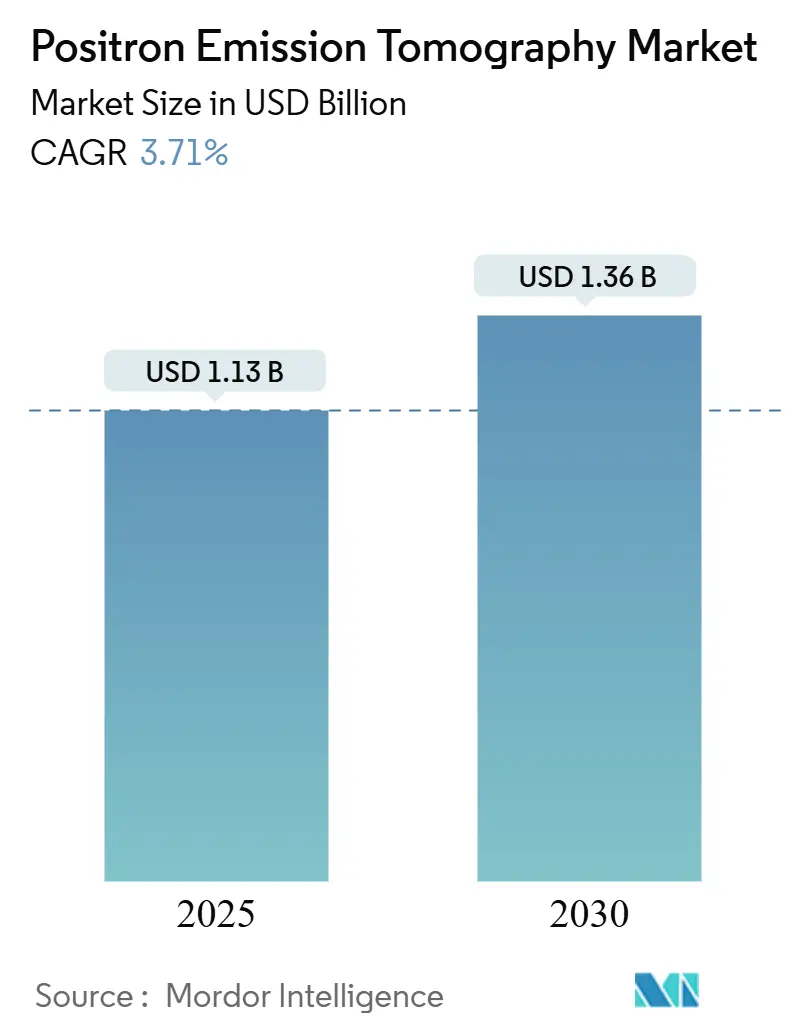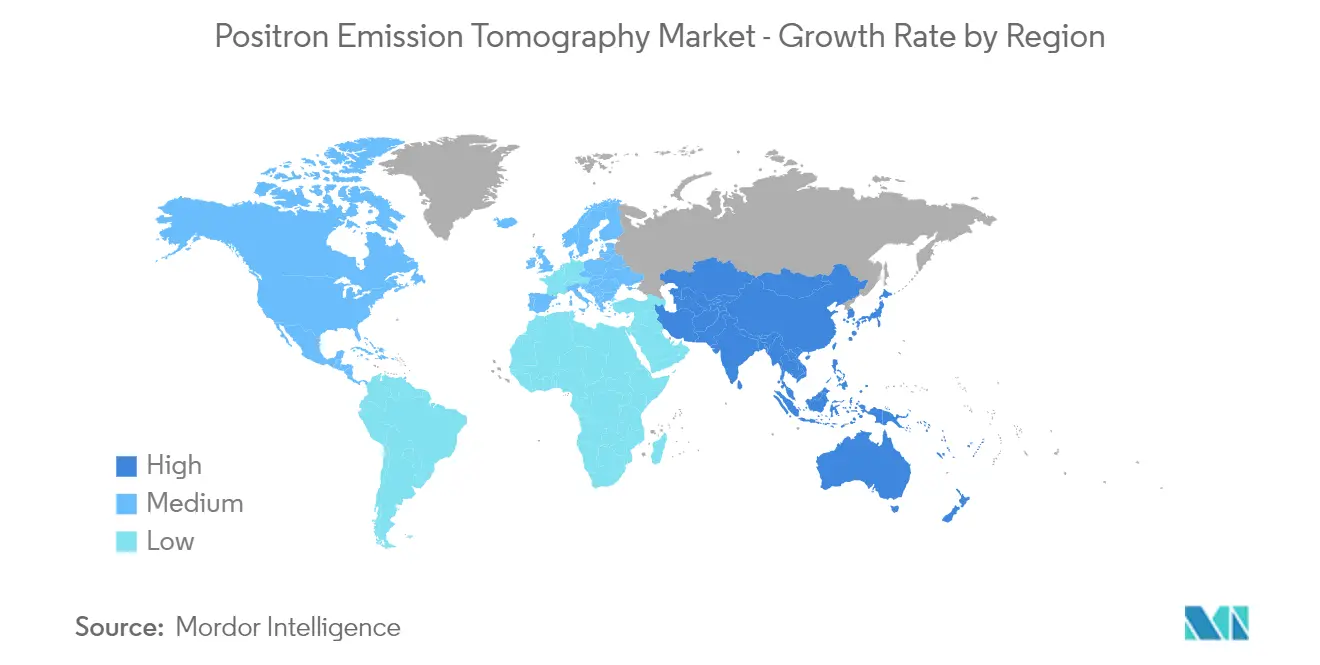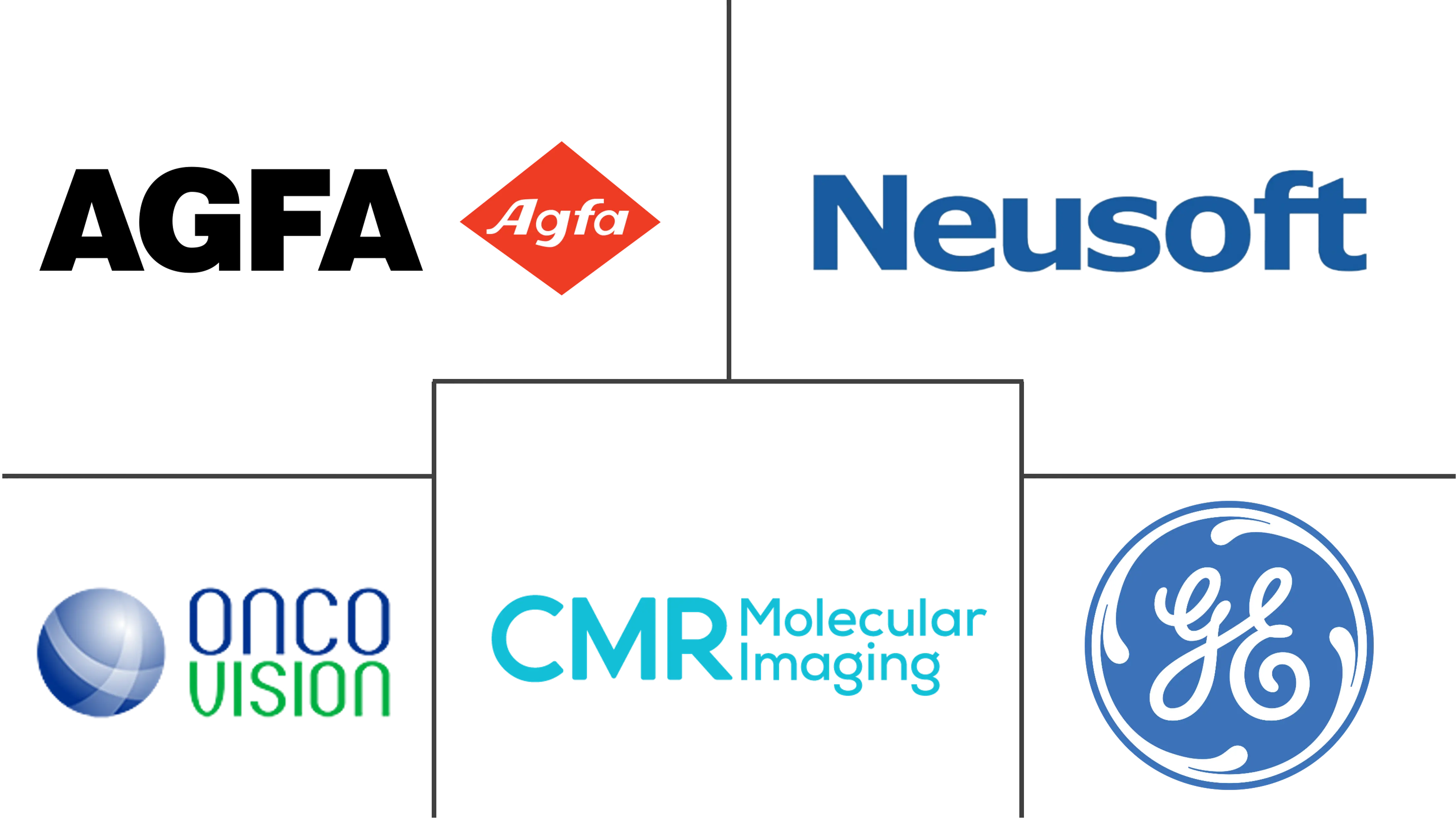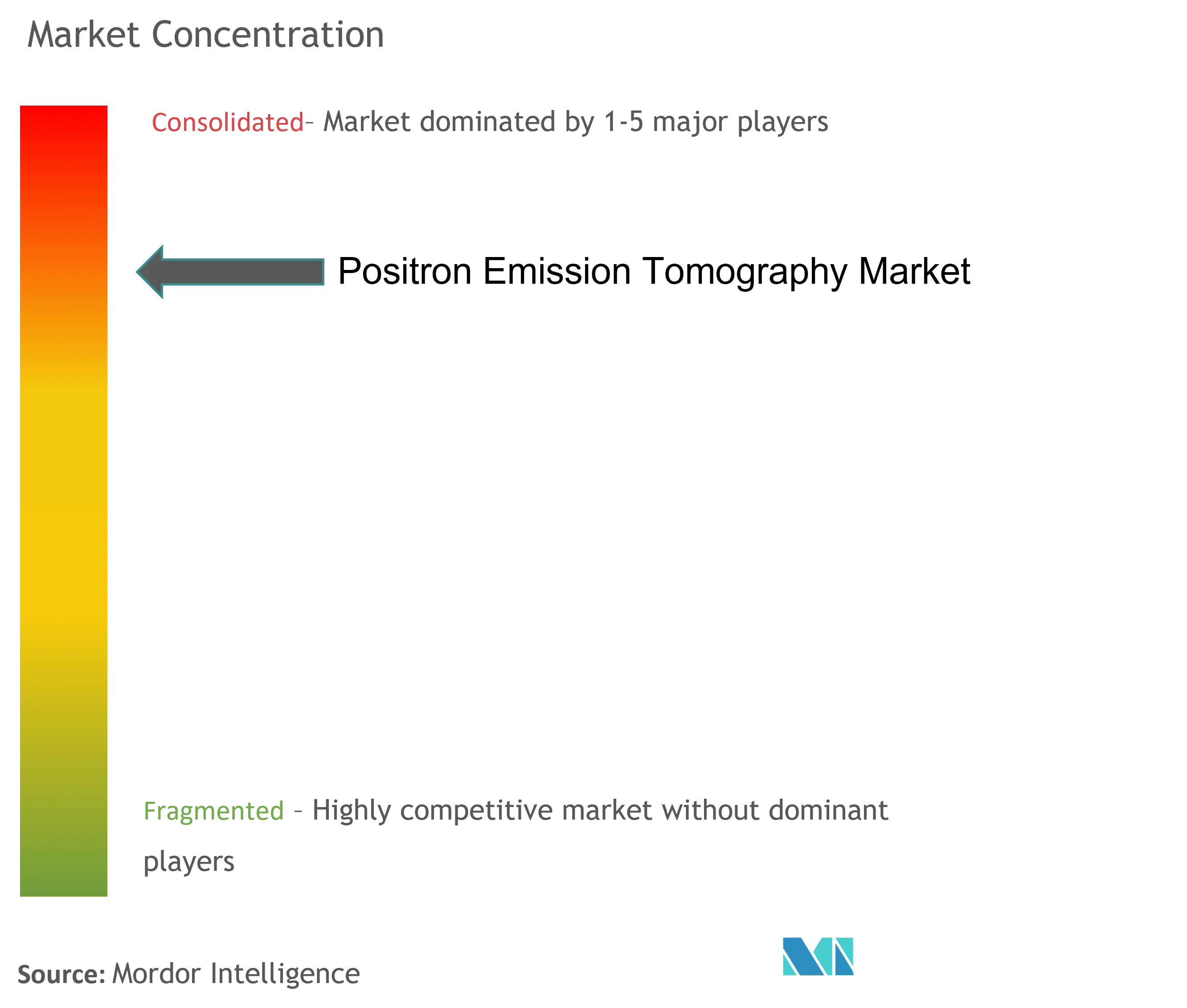
Positron Emission Tomography (PET) Market Analysis
The Positron Emission Tomography Market size is estimated at USD 1.13 billion in 2025, and is expected to reach USD 1.36 billion by 2030, at a CAGR of 3.71% during the forecast period (2025-2030).
COVID-19 significantly affected the Positron Emission Tomography market during the initial phases owing to the complete shutdown of radiological and scan services to reduce the spreading of the virus. Furthermore, due to the fear of the virus, people reduced their visits to scanning centers and clinics. According to research presented at the Society of Nuclear Medicine and Molecular Imaging (SNMMI) 2021 Annual Meeting, the effects of COVID-19 on the brain could be accurately measured with Positron Emission Tomography (PET). Newly diagnosed COVID-19 patients, who required inpatient treatment and underwent PET brain scans, were found to have deficits in neuronal function and accompanying cognitive impairment. In some, this impairment continued for six months after diagnosis. With the role of PET during the COVID-19 pandemic being adequately explored, the paradigm is likely to be applied in combating various other epidemics in the future.
Some factors driving the market growth include the increasing demand for PET analysis in radiopharmaceuticals and the integration of X-ray Tomography (CT) into PET, enhancing the capabilities of the Diagnostic Imaging market. According to the World Nuclear Association April 2022 update, around 40 million nuclear medicine procedures are performed each year, reflecting the expansion of the Nuclear Medicine Imaging market, and demand for radioisotopes is increasing by up to 5% annually. Over 10,000 hospitals worldwide use radioisotopes in medicine, and about 90% of the procedures are for diagnosis. As per the same source, in developed countries (about one-quarter of the world population), the frequency of diagnostic nuclear medicine is 1.9% per year, and the frequency of therapy with radioisotopes is about one-tenth. Also, in the United States, over 20 million nuclear medicine-related procedures are performed per year, and in Europe, about 10 million. In Australia, there are about 560,000 procedures performed per year, and of these, 470,000 are performed using reactor isotopes. The use of radiopharmaceuticals in diagnosis is growing at over 10% per year. PET evaluates organ and tissue functions using small amounts of radioactive materials known as radiotracers or radiopharmaceuticals—key components in the Molecular Imaging market— a special camera, and a computer. Hence, the rise in radiopharmaceutical analysis is likely to boost market growth over the forecast period.
Technological advancements like the introduction of Time of Flight (TOF) and the increasing popularity of hybrid imaging systems represent significant Positron Emission Tomography market trends, playing an important role in the growth of the Nuclear Imaging market and the Medical Imaging Equipment market. For instance, in June 2022, researchers from the University of Oxford developed three DL-TOF models (based on U-Net convolutional neural networks) to transform non-TOF PET data into corresponding TOF-like images. The model employed different levels of TOF strength (low, medium, or high) to trade off contrast enhancement against noise reduction. Hence, such innovations in the field of PET are likely to boost the Positron Emission Tomography market growth over the forecast period. Moreover, the market players are focused on adopting partnership strategies to expand their product portfolios. For instance, in May 2021, GE Healthcare strengthened its PET imaging portfolio by acquiring Zionexa, a prominent innovator of in vivo oncology and neurology biomarkers that help enable more personalized healthcare.
Thus, due to the increasing demand for PET analysis in radiopharmaceuticals and technological advancements in PET imaging in oncology, the Positron Emission Tomography market is expected to witness significant growth over the forecast period. However, factors such as the shorter half-life of radioisotopes and stringent regulatory guidelines are expected to impede market growth in the near future.
Positron Emission Tomography (PET) Market Trends
The Oncology Segment is Expected to Hold a Significant Market Share Over the Forecast Period
Positron Emission Tomography scanners are commonly used in clinical trials as imaging biomarkers to determine the therapeutic response to novel cancer therapeutics. The 18Fluorine-2-fluoro-2-Deoxy-d-glucose (18F-FDG) PET scanners are oncology's most widely used imaging technique. The most apparent advantage associated with PET is its ability to detect substantial changes in glucose metabolism, or even complete shutoff of the neoplastic cell metabolism in the early stages, during the treatment process. This helps clinicians detect the effectiveness of a given antineoplastic treatment much earlier than traditional radiological detection, demonstrating the importance of PET Imaging in oncology.
Furthermore, FDG-PET/CT has become a cornerstone in several oncologic procedures, such as tumor staging and restaging, treatment efficacy assessment during or after treatment ends, and radiotherapy planning. For instance, as per the article published in August 2022 by Hindawi, F-18-fluorodeoxyglucose positron emission tomography/computed tomography (F-FDG PET/CT) can be used to diagnose pancreatic cancer, staging, radiotherapy planning, evaluation of efficacy, and recurrence, and differentiation from posttreatment fibrosis. As per the same source, f-FDG PET/CT can help improve the detection of occult metastases and help patients be evaluated more accurately and effectively before surgery. Factors such as a rise in the number of cancers are likely to boost the market growth over the forecast period. For instance, according to Globocan data, the number of cancer cases is estimated to be 24,044,406 by 2030, and the number is anticipated to rise to 28,887,940 by 2040. Thus, the need for early diagnosis and treatment of cancer cases has enhanced PET scanners' usage and led to growth in the PET Scanners market.
The market players are adopting various strategies such as product launches, developments, collaborations, expansions, and acquisitions to increase their market shares. For instance, in October 2021, Wipro GE Healthcare inaugurated India's first digital positron emission tomography and magnetic resonance imaging (PET MR) at the State Cancer Institute GMC, Guwahati, Assam. GE's SIGNA PET/MR 2.0 is India's fourth PET MR scanner and the first digital one, marking a significant development in the Digital PET CT Scanner market. In July 2021, GE Healthcare backed a collaboration among Quibim, Full Body Insight, and Oncovision—leading PET Imaging Companies—to build an innovative total-body PET/CT scanner for simultaneous whole-body imaging.
Thus, due to the technological advancements in PET imaging in oncology and the increasing demand for PET analysis in cancer, the oncology segment is likely to witness growth in the Positron Emission Tomography market over the forecast period.

North America is Expected to Witness a Growth in the Positron Emission Tomography Market Over the Forecast Period
North America is expected to witness growth in the Positron Emission Tomography market owing to factors such as technological advancements in PET imaging for oncology and advanced diagnostics applications and high demand for precision diagnostics.
The rising prevalence of cancer cases, such as breast and prostate cancer, is also likely to enhance market growth significantly. For instance, as per the American Cancer Society 2022 update, the estimated number of new cancer cases in the United States is anticipated to be 1,918,030 in 2022. According to the same source, 290,560 new cases of breast cancer, 268,490 prostate cancer, and 151,030 cases of colorectum cancer are estimated in the United States in 2022. Moreover, government funding and the installation of PET Scan devices in hospitals across North America are anticipated to boost market growth over the forecast period. For instance, in April 2022, Royal Victoria Regional Health Centre (RVH) is likely to install new Medical Imaging Equipment to enable earlier detection of some cancers. The Ontario government is investing more than USD 1 million, enabling RVH to construct space in the health center's Medical Imaging department to house a positron emission tomography-computed tomography (PET-CT) scanner.
Additionally, the market players are adopting various strategies such as product launches, developments, collaborations, and acquisitions to increase their market shares. For instance, in July 2021, Hawthorne, California-based Prescient Imaging gained the 510(k) clearance for its BBX-PET machine, contributing to the growth of the Positron Emission Tomography Scanners market. In March 2021, Siemens Healthineers received FDA clearance for the Biograph Vision Quadra PET/CT Scanner, designed for clinical use and translational research to apply scientific research to create therapies and procedures that improve health outcomes. Furthermore, in October 2022, Health Canada approved Illuccix, a kit for the preparation of gallium-68 (68Ga) gozetotide (also known as PSMA-11) injection, a radioactive diagnostic agent indicated for positron emission tomography (PET) of PSMA-positive lesions in patients with prostate cancer, highlighting the expansion of the PSMA PET Imaging market. Such product approvals and launches relating to PET are likely to boost the market growth since they increase the product availability and competition in the studied region.
Thus, due to the technological advancements in PET imaging in oncology, the rise in product launches relating to PET imaging, and the increasing technological advances in PET imaging, North America is likely to witness growth in the Positron Emission Tomography market over the forecast period.

Positron Emission Tomography (PET) Industry Overview
The Positron Emission Tomography market is consolidated. The companies are implementing certain strategic initiatives such as mergers, new product launches, acquisitions, and partnerships, which help them strengthen their market positions. Leading PET Scanner Manufacturers and PET Imaging Companies include Agfa Healthcare, Oncovision, Neusoft Corporation, General Electric Company (GE Healthcare), and CMR Naviscan.
Positron Emission Tomography (PET) Market Leaders
-
Agfa Healthcare
-
Oncovision
-
CMR Naviscan
-
General Electric Company (GE Healthcare)
-
Neusoft Corporation
- *Disclaimer: Major Players sorted in no particular order
Positron Emission Tomography (PET) Market News
- August 2022: Positron Corporation, a nuclear medicine PET imaging device system and clinical services company, purchased its first PET-CT system and was on its way from its partner Neusoft Medical Systems. Positron's "Affinity PET-CT" system is on its way from China to its validation partner in the United States.
- July 2022: Radialis Inc. received clearance to market the Radialis PET Imager, an organ-targeted positron emission tomography (PET) system, in the United States. The advanced sensitivity of the Radialis PET Imager to radiotracer enables the system to produce functional images with high spatial resolution, expanding the insight available from molecular imaging.
Positron Emission Tomography (PET) Industry Segmentation
Positron emission tomography (PET) is a diagnostic technique that uses radioactive substances for imaging tissues and organ functioning. These radioactive substances are called tracers that show the activity in the body. PET has applications in both medical and research fields. Clinically, it is widely used in oncology diagnosis and as a research tool to map the human brain and heart function and support drug development.
The Positron Emission Tomography Market is Segmented by Product Type (Full Ring PET Scanners and Partial Ring PET Scanners), Application (Cardiology, Neurology, Oncology, and Other Applications), End-User (Hospitals, Diagnostic Centers, and Other End Users), and Geography (North America (United States, Canada, and Mexico), Europe (Germany, United Kingdom, France, Italy, Spain, and Rest of Europe), Asia-Pacific (China, Japan, India, Australia, South Korea, and Rest of Asia-Pacific), Middle East and Africa (GCC, South Africa, and Rest of Middle East and Africa), and South America Brazil, Argentina, and Rest of South America)). The report offers value (in USD million) for all the above segments.
| By Product Type | Full Ring PET Scanners | ||
| Partial Ring PET Scanners | |||
| By Application | Cardiology | ||
| Neurology | |||
| Oncology | |||
| Other Applications | |||
| By End-User | Hospitals | ||
| Diagnostic Centers | |||
| Other End-Users | |||
| By Geography | North America | United States | |
| Canada | |||
| Mexico | |||
| Europe | Germany | ||
| United Kingdom | |||
| France | |||
| Italy | |||
| Spain | |||
| Rest of Europe | |||
| Asia-Pacific | China | ||
| Japan | |||
| India | |||
| Australia | |||
| South Korea | |||
| Rest of Asia-Pacific | |||
| Middle East and Africa | GCC | ||
| South Africa | |||
| Rest of Middle East and Africa | |||
| South America | Brazil | ||
| Argentina | |||
| Rest of South America | |||
Positron Emission Tomography (PET) Market Research FAQs
How big is the Positron Emission Tomography Market?
The Positron Emission Tomography Market size is expected to reach USD 1.13 billion in 2025 and grow at a CAGR of 3.71% to reach USD 1.36 billion by 2030.
What is the current Positron Emission Tomography Market size?
In 2025, the Positron Emission Tomography Market size is expected to reach USD 1.13 billion.
Who are the key players in Positron Emission Tomography Market?
Agfa Healthcare, Oncovision, CMR Naviscan, General Electric Company (GE Healthcare) and Neusoft Corporation are the major companies operating in the Positron Emission Tomography Market.
Which is the fastest growing region in Positron Emission Tomography Market?
Asia Pacific is estimated to grow at the highest CAGR over the forecast period (2025-2030).
Which region has the biggest share in Positron Emission Tomography Market?
In 2025, the North America accounts for the largest market share in Positron Emission Tomography Market.
What years does this Positron Emission Tomography Market cover, and what was the market size in 2024?
In 2024, the Positron Emission Tomography Market size was estimated at USD 1.09 billion. The report covers the Positron Emission Tomography Market historical market size for years: 2021, 2022, 2023 and 2024. The report also forecasts the Positron Emission Tomography Market size for years: 2025, 2026, 2027, 2028, 2029 and 2030.
Our Best Selling Reports
Positron Emission Tomography Industry Report
Statistics for the 2025 Positron Emission Tomography market share, size and revenue growth rate, created by Mordor Intelligence™ Industry Reports. Positron Emission Tomography analysis includes a market forecast outlook for 2025 to 2030 and historical overview. Get a sample of this industry analysis as a free report PDF download.




